

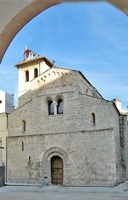
Earlier Churches
The present church, like its predecessors, stands on an artificial terrace that was built to extend the Roman forum. The so-called Sostruzione Sillane (1st century BC), which supports the west and north sides of this terrace, is attributed to the Consul Lucius Cornelius Sulla (hence "Sillane"), whose army sacked and then occupied Spoletium in 83BC. Its precise function is unknown, although it was probably part of a fortified structure.
According to tradition, the Emperor Theoderic built a palace on the terrace here in the 5th century that was later used by Lombard and Carolingian dukes. The same tradition insists that Duke Theodelap of Spoleto (ca. 602-50) established the palatine chapel on this site. Two pieces of evidence support the hypothesis that sant’ Eufemia does indeed date back to this period:
-
✴St Euphemia was one of the most popular virgin martyrs of the Eastern church, and the Syrian monks who came to Spoleto in the 6th century might have brought the cult with them.
-
✴The capital (6th century) of the 3rd column on the right of the matrons' gallery of the present church (see below) could have come from an earlier church on the site.
Gunderada, the abbess of a Benedictine nunnery here, discovered the relics of St John of Spoleto at the time of the Emperor Otto II (973-83) and translated them to the church, which she then renovated. A later abbess, Berta, commissioned a life of St John from Brother John of Montecassino, and it was in this account that the church and nunnery were first documented. Following the translation of the relics, the church became known as SS Giovanni e Eufemia.

Present Church (12th century)
The present church is unusually tall and has the only matrons’ gallery in Umbria. It is reminiscent of San Lorenzo, Verona, which was rebuilt in 1117, a fact that suggests that Sant’Eufemia was also rebuilt in the early 12th century. The reasons for the rebuilding and for the apparent link with the church in Verona are not known. It seems that Bishop Enrico Gualfriedi translated the relics to San Pietro in 1130, and this could have been associated with the rebuilding.
The church and ex-nunnery subsequently passed into the hands of the bishops of Spoleto, perhaps in 1130 or perhaps at the end of the papal schism in 1177. Bishop Transarico left the old episcopal palace near the Duomo for what must have been temporary accommodation at San Gregorio Maggiore in ca. 1178: it seems likely that the new Palazzo Vescovile was built on the site of the ex-nunnery soon after. However, the earliest surviving documentation of this palace “close to San Giovanni” dates to 1231.
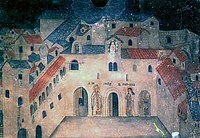
This fresco in the old chancellery of Palazzo Vescovile shows Sant’ Eufemia in the time of Bishop Galardo (ca. 1374-83), by which time:
-
✴it was incorporated into the east wing of that palace; and
-
✴its facade was decorated with frescoes of SS John of Spoleto and Euphemia.
In ca. 1446, Marco Condulmer (the brother of Pope Eugenius IV, who appointed him as administrator of the diocese) changed the dedication of the church to Santa Lucia. (The relics of St Lucy were in his native Venice, and he might have transferred some of them to Sant’ Eufemia).
From the 16th century, the church was divided into two storeys:
-
✴the lower floor remained open for worship; while
-
✴the upper floor formed part of Palazzo Vescovile.
The church was restored in 1907-54, at which point the adjoining parts of Palazzo Vescovile were demolished. The church is now usually entered by an overhead passage from the Museo Diocesano, which is in the upper floor of the north wing of Palazzo Vescovile.
Exterior
The façade (illustrated above) retains its central bifore window, which is visible in the fresco above.
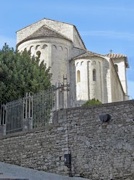
Interior
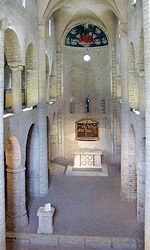
As noted above, a corridor in Palazzo Vescovile, which is reached from the Museo Diocesano, leads to the matrons' gallery, which runs along the upper part of the side aisles and counter-facade. This is the only such gallery in any surviving church in Umbria. The capital (6th century) of the 3rd column on the right of the matrons' gallery might have come from the first church on this site.
Steps on the left lead down to the church.
Pilaster (9th century)

Altar frontal (13th century)
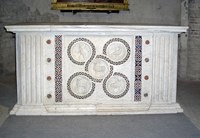
The original high altar of Sant' Eufemia was accidentally destroyed during the restoration i the early 20th century. The marble frontal that was used for the replacement altar came from the high altar of the Duomo. Bishop Maffeo Barberini described it in its original location during his pastoral visit of 1610. It probably remained in its original location until 1792, the date at which the present high altar of the Duomo was installed.
The frontal has reliefs in tondi of the Agnus Dei and the symbols of the Evangelists.
God the Father with angels (early 14th century)
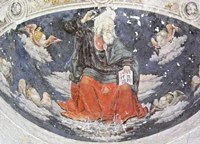
This fresco, which is the only one to survive in the apse, was restored in the 16th century.
St Lucy (1455)

Virgin Martyr (15th century)

Dormition of the Virgin (16th century?)
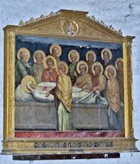
Art from the Church
Sant’ Eufemia Tryptych (1450)
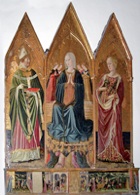
The altarpiece is usually attributed to Bartolomeo da Miranda, although Filippo Todini has rejected this and designated it as the autograph work of the Maestro del Trittico di Sant’ Eufemia. It depicts the Virgin of the Assumption with SS John of Spoleto and Lucy, with three scenes the martyrdom of St Lucy in the predella.

